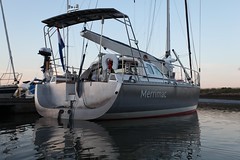
One of the decisions that we made early on when building our new boat was to have an array of solar cells on a spoiler at the rear. Well, I wanted them and had to convince the admiral, but anyway. The reason to choose for PV (Photo Voltaic) solar cells is that they work without needing any supervision when you are away from the boat, maintenance is limited to an irregular cleaning interval and most importantly on a sailboat, that they do not make any noise.
What we definitely did not want was flexible panels on top of the pilot house or deck. Not only are the flexible panels a lot less efficient by themselves, having multiple entry points for the cables makes for leaks, and they also heat up because they cannot shed their heat radiating downwards. Hot solar panels work slower. This then is a bad compromise: the warmer the climate the more likely you are that you are going to have a nice overhead sun but your panels will not be putting out as much. Just at the time that your fridge is working overtime! So no flexible panels for us.

As boat #1 had a quite nice antenna and PV spoiler at the very rear of the boat, we opted for the same manner of construction. Although the spoiler can be considered ugly, it keeps out of the way, provides for a good way of lifting the rowing dinghy. It turns out that it's also a half-decent bimini, although for that purpose it could even be larger.
Technically we used the best panels we could find. I did not want the total panel area to be wider than the boat or stick out from the rear; this way you can safely enter a lock without fear of endangering the panels. On the front side the panels are limited by the backstay. This gave us an an area of about 3,30 by 1 m. This enabled us to fit 6 panels rated at 100 Wp.
Given that we're (still) in the NW of Europe at 52° N and that Wp is a theoretical maximum, I was told that a fixed setup (on land) of 600 Wp would bring in about 500 kWh per year. On the downside, our boat's panels are not angled, and there is some shadow from backstay and antennas. Fortunately the sun tends to shine more at sea or near the sea. So I figured 25 % loss, e.g. 375 kWh per year or a 1 kWh per day average. Since the sun shines a lot more in the summer, figure about 70% more during summer, which happily coincides with our summer holiday!
In practice

So how did this work out? Very well. Last year we never used any shore power whilst cruising, but did not yet keep a full tally. Last winter when we were on board and the Kabola heater was running full blast (outside -7 C) we obviously did use shore power. Solar cells were not doing much then when the sun is above the horizon only a little and only for maybe 8 hours!
Back to today, and here are some snapshots from my monitoring app from this week -- end of May. This means the sun officially rises at about 6:30 and goes down at 21:30. In the first image you can see the current at which the house battery is being charged or discharged. The at-rest usage this week is 1,7 A (monitoring stuff, all mastervolt equipment on, winches and hydraulics powered but the fridge is off.)
These images span a week running from Friday morning to Friday morning. On Saturday and sunday I was on board, using all sorts of stuff including running the inverter for watching TV and some chores. I also did some upgrades to the monitoring software, so you see a 'glitch' in the data where the graph is interrupted. From Monday onwards no-one was aboard, and you can see that on Monday the sun was out, as the effective current into the batteries reached a maximum of 13.4 A. Combined with the load that means the solar array was pumping out 15.1 A.

You can also see that on Wednesday the batteries were reaching a completely full charge.
So you can see that certainly they are doing what they were supposed to do: deliver us the boat on a full charge in summer.



